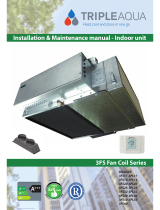Page is loading ...

GUIDE SHEET
Flexible Ducting
Installation
for Small Ducted Units
General Rules
1. If a unit is supplied with specific size duct spigots, then
DO NOT use ducting of a smaller size. If the duct run is
more than 3 metres, stepping up to the next size is
recommended.
2. If wanting to change the existing number of outlets on
ISDL or IMDL low profile units, then the cross sectional
area of the proposed new outlets must be EQUAL TO OR
GREATER than that of the original outlets — it MUST NOT
BE LESS.
3. DO NOT blank off an outlet at the spigot plate.
4. AVOID short outlet plenums with side outlets close to the
unit, especially with draw-through units such as IMD and
ISD models. This type of plenum generates high pressure
losses, turbulence and noise. Longer plenums with side
outlets away from the unit or short plenums with front
outlets are preferred.
POOR
0.5 R
18 Pa @ 4.5 m/s 10 Pa @ 4.5 m/s
1.5 R
28 Pa @ 4.5 m/s
0.5 R
12 Pa @ 4.5 m/s
1.5 R
5. Use radii of at least 1.5 times the duct diameter for bends.
Tight radii bends can double the pressure loss.
6. 180° 'U' bends surprisingly do not generate double the
pressure loss of a 90° bend but something much less than
double.
7. Avoid 'S' bends as these generate more than double the
pressure loss of a 180° bend in fact about 2.5 times the
pressure loss.
8. DO NOT mis-shape the circular ducting,
i.e. don’t squash it.
REASONABLE
0.5 R
1.5 R
30 Pa @ 4.5 m/s65 Pa @ 4.5 m/s
Introduction
The purpose of this guide is to provide information that assists installers to achieve the desired air flow from temperzone Split
System Indoor units and Chilled Water Fan Coil units. It is also useful for investigating systems performing poorly.
Note: Many of these units are designed specifically for low static pressure drops therefore duct losses can be significant.
For simplicity, information is based on tests conducted using 250 mm diameter flexible duct. Smaller flexible duct diameters have
worse characteristics than larger diameters.
GOOD

11/03 Pamphlet No. 2203 © temperzone ltd 2003
Duct Velocity
1.5 R
21 Pa @ 4.5 m/s53 Pa @ 4.5 m/s
Duct Velocity Duct Velocity
16 Pa @ 4.5 m/s
more airless air
3 metres
250Ø
9 Pa
Equal air
flow in both
ducts
6 metres
300Ø
8 Pa
9. Side entry diffuser boxes generally have a much lower pressure loss than a top entry diffuser; top is satisfactory if the flexible
duct is supported and makes a gentle radius entry (1.5 x duct diameter). However, if flexible duct is left unsupported then it
will kink when connected to the diffuser adding dramatically to the pressure loss. Side entry boxes also improve air
distribution.
10. Oversize the flexible duct for long runs or better still incorporate some rigid straight circular duct.
11. Try to achieve roughly equal pressure losses through each leg.
12. DO NOT coil up surplus flexible duct for short runs, CUT to suit.
Poor Installation Ideal Installation
Tight
bend
POOR
design
Plenum
Bends too tight
6m
2m 1.5m Straight
To
Entry
Diffusers
250Ø
250Ø
250Ø
3m
250Ø
5m 250Ø 250Ø
UNIT
6m leg
3m
350Ø
Plenum design ideal for
Draw-Through Unit,
ie ISD and IMD models.
250Ø
increase
size to 300Ø
250Ø
3m
size to 300Ø
5m leg
increase
350Ø
Large
radius
bends
4 x Duct
Diameter
Diffuser with side
entry boots
UNIT
/



